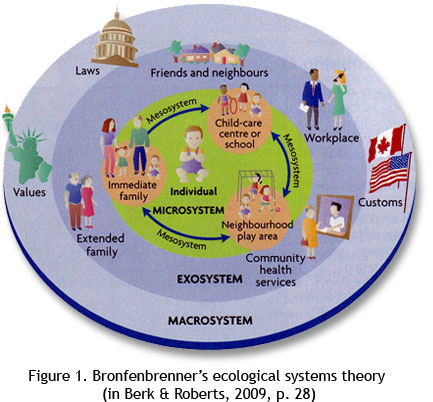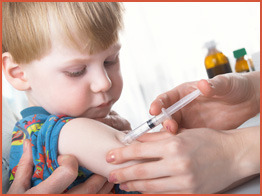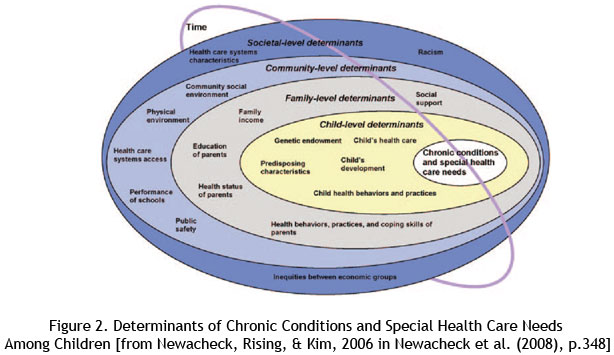| Bronfenbrenner’s Ecological Model |
| In his original model, Bronfenbrenner (1979) outlines four different levels that interact with one another: the microsystem, the mesosystem, the exosystem, and the macrosystem. A visual representation of his model is shown in Figure 1. Bronfenbrenner’s (1979) definition of each system provides further clarification. |
 Microsystem - “a pattern of activities, roles, and interpersonal relations experienced by the developing person in a given setting with particular physical and material characteristics” (p. 22). Sample settings can include the home, school, and child care centre. Tudge et al. (2000) note that there is “a tendency to focus on development within a single microsystem – on development within the family, or at school, or with the peer group” (p. 2). Microsystem - “a pattern of activities, roles, and interpersonal relations experienced by the developing person in a given setting with particular physical and material characteristics” (p. 22). Sample settings can include the home, school, and child care centre. Tudge et al. (2000) note that there is “a tendency to focus on development within a single microsystem – on development within the family, or at school, or with the peer group” (p. 2). |
 Mesosystem - “the interrelations among two or more settings in which the developing person actively participates (such as: for a child, the relations among home, school, and neighborhood peer group; for an adult, among family, work, and social life)” (p. 25) Mesosystem - “the interrelations among two or more settings in which the developing person actively participates (such as: for a child, the relations among home, school, and neighborhood peer group; for an adult, among family, work, and social life)” (p. 25) |
 Exosystem - “one or more settings that do not involve the developing person as an active participant, but in which events occur that affect, or are affected by, what happens in the setting containing the developing person. Examples of an exosystem … might include the parent’s place of work, a school class attended by an older sibling, the parents’ network of friends …” (p. 25) Exosystem - “one or more settings that do not involve the developing person as an active participant, but in which events occur that affect, or are affected by, what happens in the setting containing the developing person. Examples of an exosystem … might include the parent’s place of work, a school class attended by an older sibling, the parents’ network of friends …” (p. 25) |
 Macrosystem - “consistencies … at the level of the subculture or the culture as a whole, along with any belief systems or ideology underlying such consistencies” (p. 26). Some examples provided include the differences in playgrounds, schools or coffee shops in different counties. Macrosystem - “consistencies … at the level of the subculture or the culture as a whole, along with any belief systems or ideology underlying such consistencies” (p. 26). Some examples provided include the differences in playgrounds, schools or coffee shops in different counties. |
  |


 Developmental Health has been defined as the physical and mental health, well-being, coping and competence of human beings (Keating, 1999) and is the combination of health and developmental outcomes.
Many different factors can positively or negatively affect developmental health. If we want to impact a child's development and ultimate life trajectory, we must understand the key risk and protective factors that strongly influence children's future health and well-being.
Developmental Health has been defined as the physical and mental health, well-being, coping and competence of human beings (Keating, 1999) and is the combination of health and developmental outcomes.
Many different factors can positively or negatively affect developmental health. If we want to impact a child's development and ultimate life trajectory, we must understand the key risk and protective factors that strongly influence children's future health and well-being.  A similar type of model, often used in the context of social pediatrics, shows the determinants of chronic conditions and special health care needs among children (see Figure 2). As in Bronfenbrenner’s model, each level is nested within another system, and incorporates factors affecting the child, family, community, and society. A common feature of both models is that the child is found at the core, and remains the central focus. In this model (see Newacheck et al., 2008), a wide range of determinants are outlined. They are essentially based on the Determinants of Health (Health Canada, 2001; WHO, 2003). These physical and social factors affect a person’s health and well-being, but have an even more significant impact on a child’s trajectory of development.
A similar type of model, often used in the context of social pediatrics, shows the determinants of chronic conditions and special health care needs among children (see Figure 2). As in Bronfenbrenner’s model, each level is nested within another system, and incorporates factors affecting the child, family, community, and society. A common feature of both models is that the child is found at the core, and remains the central focus. In this model (see Newacheck et al., 2008), a wide range of determinants are outlined. They are essentially based on the Determinants of Health (Health Canada, 2001; WHO, 2003). These physical and social factors affect a person’s health and well-being, but have an even more significant impact on a child’s trajectory of development.
